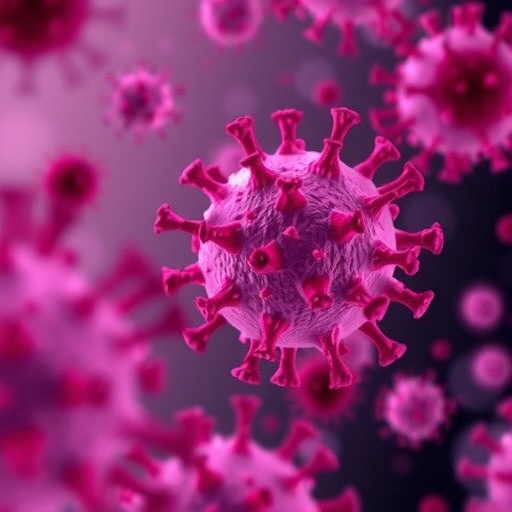In a groundbreaking advancement in the understanding of immune recognition against SARS-CoV-2, researchers have unveiled the molecular underpinnings that govern a potent CD8+ T cell response restricted by HLA-C molecules targeting an immunodominant nucleocapsid epitope of the virus. This discovery not only sheds light on the sophisticated interplay between viral epitopes and the human immune system but also opens new avenues for vaccine development and immunotherapeutic strategies that harness the specificity and efficacy of T cell mediated immunity.
The immune system’s ability to identify and eliminate infected cells is paramount in controlling viral infections. CD8+ T cells, also known as cytotoxic T lymphocytes, play a crucial role in this defense by recognizing viral peptides presented on infected cells via Major Histocompatibility Complex (MHC) class I molecules. Among these, human leukocyte antigen C (HLA-C) molecules have historically been less studied compared to their HLA-A and HLA-B counterparts. However, this recent study pivots attention towards HLA-C’s integral role in antiviral immunity, particularly against SARS-CoV-2, the causative agent of COVID-19.
At the core of this research lies the nucleocapsid protein of SARS-CoV-2, a structural protein essential for viral RNA packaging and replication. The nucleocapsid is highly conserved and abundantly expressed during infection, making it a prime target for immune recognition. The team focused on elucidating how an immunodominant epitope from this nucleocapsid is presented by HLA-C molecules and subsequently recognized by CD8+ T cells, thereby orchestrating a potent antiviral response.
Utilizing a multi-disciplinary approach that combines structural biology, immunology, and virology, the researchers employed X-ray crystallography to capture the three-dimensional structure of the HLA-C molecule bound to the nucleocapsid-derived peptide. This high-resolution snapshot revealed precise interactions between the peptide and the peptide-binding groove of HLA-C, highlighting amino acid residues critical for stable binding and antigen presentation. These exquisite molecular details provide the basis for understanding the specificity and strength of the immune recognition.
In parallel, functional assays demonstrated that CD8+ T cells bearing T cell receptors (TCRs) specific to this HLA-C-restricted epitope exhibited robust cytotoxic activity against infected cells expressing the nucleocapsid. Remarkably, this T cell response was characterized by high affinity and avidity, underscoring the ability of the immune system to mount a formidable defense through HLA-C-mediated pathways. This finding challenges previous assumptions about the subordinate role of HLA-C molecules in antiviral immune responses.
Furthermore, the study’s flow cytometry and single-cell sequencing analyses delineated the phenotypic and transcriptional profiles of these virus-specific CD8+ T cells. The data painted a picture of a highly functional and polyfunctional T cell population capable of producing multiple antiviral cytokines and exhibiting cytotoxic granule release, key attributes for effective viral clearance. These insights deepen our understanding of the immune landscape during SARS-CoV-2 infection and could inform biomarker development for disease prognosis.
An intriguing aspect of this research is the conservation of the immunodominant nucleocapsid epitope across various SARS-CoV-2 variants. Bioinformatic analyses revealed minimal mutational changes within this region, suggesting that the epitope remains a stable target despite viral evolution. This stability enhances the potential for designing broadly protective vaccines or T cell-based therapies that exploit this particular epitope-HLA-C axis.
The researchers also explored the impact of HLA-C genetic polymorphisms on the presentation efficacy of the nucleocapsid epitope and the ensuing T cell responses. Given the diversity of HLA alleles in the human population, understanding which variants mediate optimal immune protection is critical for personalized immunotherapy and vaccine design. Their findings indicate that certain HLA-C alleles confer superior binding and presentation capacity, correlating with more vigorous antiviral T cell activity.
Beyond the mechanistic insights, this study emphasizes the therapeutic implications of harnessing HLA-C-restricted T cell responses. Vaccines traditionally focus on eliciting neutralizing antibodies or CD8+ T cells restricted to HLA-A and HLA-B molecules. By integrating epitopes that engage HLA-C, future immunizations could expand the breadth and depth of immune protection, especially in individuals who may not respond optimally through conventional pathways.
Moreover, the molecular data derived from the structural analyses could facilitate the rational design of peptide-based vaccines or immunomodulatory agents. Tailoring peptides to enhance binding affinity to HLA-C molecules or engineering TCR-like molecules to recognize the viral peptide-HLA complex might revolutionize antiviral strategies against COVID-19 and potentially other viral infections.
In light of the persistent threat posed by emerging SARS-CoV-2 variants and waning immunity, understanding the full repertoire of immune responses is urgently needed. This research decisively positions HLA-C-restricted CD8+ T cells as potent antiviral effectors and underscores the importance of inclusive approaches that consider all facets of the adaptive immune response.
From a virological perspective, the nucleocapsid protein’s role as an immunodominant target reinforces the concept of targeting conserved viral elements for durable immunity. Unlike the spike protein, which undergoes frequent mutations compromising antibody efficacy, nucleocapsid epitopes offer a stable alternative or complement in immune interventions.
Additionally, this study bridges the gap between structural immunology and clinical relevance by highlighting the interactions at the atomic level that translate into robust cellular immunity. This convergence stresses how fundamental research informs therapeutic innovation and public health strategies in real-time during a pandemic.
In conclusion, the meticulous dissection of the HLA-C-restricted CD8+ T cell response against a key SARS-CoV-2 nucleocapsid epitope represents a milestone in antiviral immunology. It demonstrates the untapped potential of HLA-C molecules in mediating effective immune surveillance and paves the way for next-generation immunotherapeutics that exploit this pathway to combat COVID-19 and possibly future zoonotic outbreaks. As the scientific community continues to decode the immune system’s complexity, such revelations promise to tip the scales in our favor against viral adversaries.
Subject of Research: Molecular mechanisms of HLA-C-restricted CD8+ T cell responses to SARS-CoV-2 nucleocapsid epitope
Article Title: Molecular basis of potent antiviral HLA-C-restricted CD8+ T cell response to an immunodominant SARS-CoV-2 nucleocapsid epitope
Article References:
Goto, Y., Ahn, Y.M., Toyoda, M. et al. Molecular basis of potent antiviral HLA-C-restricted CD8+ T cell response to an immunodominant SARS-CoV-2 nucleocapsid epitope. Nat Commun 16, 8062 (2025). https://doi.org/10.1038/s41467-025-63288-3
Image Credits: AI Generated




